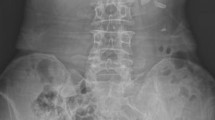Abstract
The objective of the study was to investigate the safety and efficacy of flexible ureteroscopy and holmium laser lithotripsy for the management of patients with autosomal dominant polycystic kidney disease (ADPKD) and associated nephrolithiasis. Between 2005 and 2010, flexible ureteroscopic stone treatment was attempted in 13 patients with ADPKD. Two patients had bilateral renal stones. Most of the stones were located in the renal pelvis and/or calices with a stone size 1.7 cm in the largest diameter. The success rate and morbidity and complications were recorded. A total of 45 intrarenal calculi with a mean stone size of 5.6 mm (range 3–17) were identified. The mean number of stones per patients was 3.2 (range 2–5). The mean number of primary procedures was 1.2 (range 1–2). The overall stone-free rates after one and two procedures were 84.5 and 92.3%, respectively. Complications occurred in three procedures and consisted of low-grade fever in one procedure, flank pain in another procedure and stent pain in another procedure. No patient died. Flexible ureteroscopy with holmium laser lithotripsy is a safe and effective method for the treatment of patients with ADPKD and associated nephrolithiasis.

Similar content being viewed by others
References
Delaney VB, Adler S, Bruns FJ, Licinia M, Segel DP, Fraley DS (1985) Autosomal dominant polycystic kidney disease: presentation, complications, and prognosis. Am J Kidney Dis 5:104–111
Levine E, Grantham JJ (1985) High-density renal cysts in autosomal dominant polycystic kidney disease demonstrated by CT. Radiology 154:477–482
Ng CS, Yost A, Streem SB (2000) Nephrolithiasis associated with autosomal dominant polycystic kidney disease: contemporary urological management. J Urol 163:726–729
Torres VE, Erickson SB, Smith LH, Wilson DM, Hattery RR, Segura JW (1988) The association of nephrolithiasis and autosomal dominant polycystic kidney disease. Am J Kidney Dis 11:318–325
Grampsas SA, Chandhoke PS, Fan J, Glass MA, Townsend R, Johnson AM, Gabow P (2000) Anatomic and metabolic risk factors for nephrolithiasis in patients with autosomal dominant polycystic kidney disease. Am J Kidney Dis 36:53–57
Delakas D, Daskalopoulos G, Cranidis A (1997) Extracorporeal shockwave lithotripsy for urinary calculi in autosomal dominant polycystic kidney disease. J Endourol 11:167–170
Umbreit EC, Childs MA, Patterson DE, Torres VE, LeRoy AJ, Gettman MT (2010) Percutaneous nephrolithotomy for large or multiple upper tract calculi and autosomal dominant polycystic kidney disease. J Urol 1:183–187
AL-Kandari AM, Shoma AM, Eraky I, EI-Kenawy MR, AI-Eezi H, EI-Kappant HA (2009) Percutaneous nephrolithotomy for management of upper urinary tract calculi in patients with autosomal dominant polycystic kidney disease. Urology 74:273–277
Cocuzza M, Colombo JR Jr, Ganpule A, Turna B, Cocuzza A, Dhawan D, Santos B, Mazzucchi E, Srougi M, Desai M, Desai M (2009) Combined retrograde flexible ureteroscopic lithotripsy with holmium YAG laser for renal calculi associated with ipsilateral ureteral stones. J Endourol 23:253–257
Breda A, Ogunyemi O, Leppert JT, Lam JS, Schulam PG (2008) Flexible ureteroscopy and laser lithotripsy for single intrarenal stones 2 cm or greater—is this the new frontier? J Urol 3:981–984
Turna B, Stein RJ, Smaldone MC, Santos BR, Kefer JC, Jackman SV, Averch TD, Desai MM (2008) Safety and efficacy of flexible ureterorenoscopy and holmium:YAG lithotripsy for intrarenal stones in anticoagulated cases. J Urol 4:1415–1419
Breda A, Ogunyemi O, Leppert JT, Schulam PG (2009) Flexible ureteroscopy and laser lithotripsy for multiple unilateral intrarenal stones. Eur Urol 55:1190–1196
Torres VE, Wilson DM, Hattery RR, Segura JW (1993) Renal stone disease in autosomal dominant polycystic kidney disease. Am J Kidney Dis 22:513–519
Pak CY (1994) Citrate and renal calculi: an update. Miner Electrolyte Metab 20:371
Mariani AJ (2004) Combined electrohydraulic and holmium:YAG laser ureteroscopic nephrolithotripsy for 20 to 40 mm renal calculi. J Urol 172:170–174
Deliveliotis C, Argiropoulos V, Varkarakis J, Albanis S, Skolarikos A (2002) Extracorporeal shock wave lithotripsy produces a lower stone-free rate in patients with stones and renal cysts. Int J Urol 9:11–14
Author information
Authors and Affiliations
Corresponding author
Additional information
L. Yili and L. Yongzhi contributed equally to this work.
Rights and permissions
About this article
Cite this article
Yili, L., Yongzhi, L., Ning, L. et al. Flexible ureteroscopy and holmium laser lithotripsy for treatment of upper urinary tract calculi in patients with autosomal dominant polycystic kidney disease. Urol Res 40, 87–91 (2012). https://doi.org/10.1007/s00240-011-0390-x
Received:
Accepted:
Published:
Issue Date:
DOI: https://doi.org/10.1007/s00240-011-0390-x




